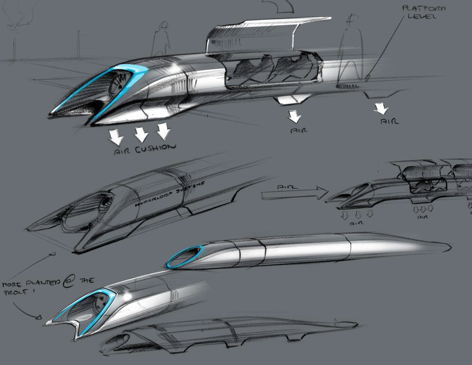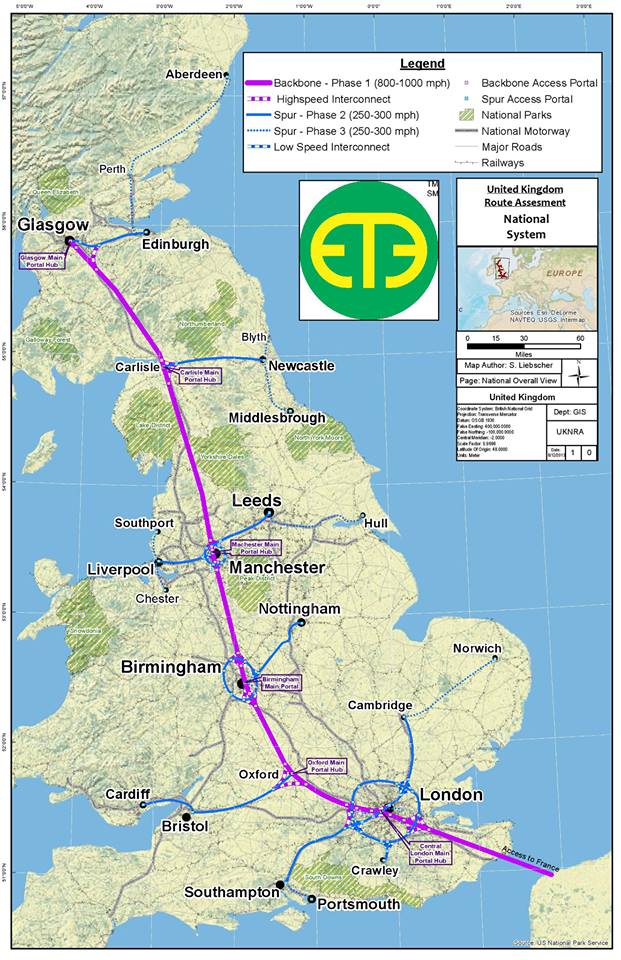It’s extremely tempting when you work on a publication devoted to new technologies to use science fiction analogies. It’s got to the point where I’m extremely tempted to put a ban on all mentions of Minority Report in our style guide (although I have to admit I did reference it myself last month). But when a concept comes along that’s so clearly science fiction-y, it’s almost impossible to avoid it.
When Elon Musk made his long-awaited announcement of his Hyperloop concept last week, all those science fiction comparisons came out. For those readers who’ve been out of the loop, Hyperloop is a high-speed medium-to-long distance travel concept where passengers ride in carriages or ‘pods’ contained within a sealed tube with low air pressure to minimise resistance to the pod’s forward motion. To minimise it even further, the pods are propelled using a magnetic levitation (maglev) system, with linear motors placed at intervals along the floor of the tube providing the impulse.

It’s not a new idea. Vacuum trains (sometimes known as vactrains) were first dreamed up in the early 19th century, and London had a pneumatic railway in Crystal Palace which operated for a year in 1864. The ‘father of rocketry’, Robert Goddard, was also among the conceptual pioneers in the early 20th century. And, bringing out that sci-fi connection, they feature in the works of Ray Bradbury, Arthur C Clarke (who also proposed the space elevator), Robert Heinlein, and in films like Logan’s Run. If you were one of the people who managed to stay awake during the first Star Trek film, you might have seen one in future San Francisco.
Musk has come up with some clever additions to the idea. Unlike most vactrain concepts, his tube isn’t completely evacuated: it’s far too difficult to pull a perfect vacuum even in a relatively small tube, let alone one which stretches from Los Angeles to San Francisco and is big enough to enclose something the size of a bus. Instead, his tube is kept at 100Pa (about a thousandth of an atmosphere). Each pod is equipped with a compressor on the front which sucks the air out of the way and pumps it underneath the pod so that it acts as an air cushion, keeping the nickel-alloy skis on which the pod slides from making direct contact with the tube floor. With linear motors placed every 100km, this means that the pods will reach a speed of 1220km/hr — not far short of the current land-speed record — in about 35 seconds from a standing start, with the whole journey from Southern to Northern California taking 35min. That’s about half the time it currently takes to fly.
The whole system would be powered by solar panels on the roof of the tube, with energy to spare, according to Musk — the photovoltaics would generate some 57MW, which is three times as much as he says the system will consume. The tube would be carried on pylons, 6m tall, placed every 30m — and if you place them alongside an existing highway, it solves land-purchase problems. And the cost? Musk reckons about $7bn (£4.5bn).
This all sounds somewhat too good to be true, and we at Engineer Towers have joined in with everyone trying to pick holes in the plan. Is sealing technology up to making a leak-proof tube that long? How much energy will it take to keep those pumps operating all the time to maintain the partial vacuum? How will the pods be kept at a comfortable temperature, when you can’t pump in cool air from outside? Is current photovoltaic technology up to it? What about maintenance and emergency rescue? And can it really be that cheap?
We don’t have the answers anymore than any one else does — and we’re waiting with interest for the results of various studies. But a lot of the scepticism has been allayed by the fact that it’s Elon Musk who’s proposing it. Although not an engineer by training (he has degrees in physics and economics) Musk has a well-deserved reputation for making technology happen. You can’t ignore Tesla Motors, the world’s most prominent pure-electric car manufacturer, or SpaceX, the only private company to send spacecraft to the International Space Station. And as for photovoltaics, Musk is also a co-founder and chairman of the largest supplier of domestic solar power in the US, Solar City. It’s probably safe to say he knows his solar stuff. And, of course, he has the money, mainly from his first venture, the online financial service Paypal.
Some might say that none of these ventures break new ground technically, but then neither does Hyperloop, at least in the terms Musk is proposing. And with banks notoriously unwilling to invest in both low-yield infrastructure projects and risky new technologies, it might be that only someone with Musk’s billons could take such a project forward.
Musk put the idea forward in despair at the proposed cost of a high-speed train link between LA and San Francisco — a situation which is, of course, parallelled here in the UK. Could a Hyperloop replace HS2? It probably couldn’t run on solar power — the home counties are a far cry from sunny California, even in a good summer. But the same problem applies. Who’d pay for it? HS2 is predicted on proved technology — proved now, and not in the 30 years it’d take to build it. Even if you built the tube alongside the M1 and M6, it’s hard to see the Treasury going for it.

It’s tempting to think that back in Victorian days, the system would be up and running by now. Entrepreneur-engineers such as Brunel, Boulton, Watt and the Stephensons weren’t put off by the risks of developing technology and drove the railways across the country by sheer force of will (and, crucially, deep pockets). Are technology billionaires like Musk the modern equivalent of these pioneers, or their US equivalents like Edison? And if so, do we have anyone similar in the UK? Names like Richard Branson and Herman Hauser spring to mind, but I have a nasty feeling that the closest equivalent is Simon Cowell, and I dread to think what the background music in a Syco Hyperloop would be.
At the moment, Hyperloop is — quite literally — a pipe dream, but Musk has recently stepped back slightly from his original statement that he wouldn’t develop the system himself, saying that he’d probably consider building a demonstration version. That would certainly dispel a lot of the doubts. It’s certainly part of the science fiction future I’d like to live in.





Nanogenerator consumes CO2 to generate electricity
Nice to see my my views being backed up by no less a figure than Sabine Hossenfelder https://youtu.be/QoJzs4fA4fo